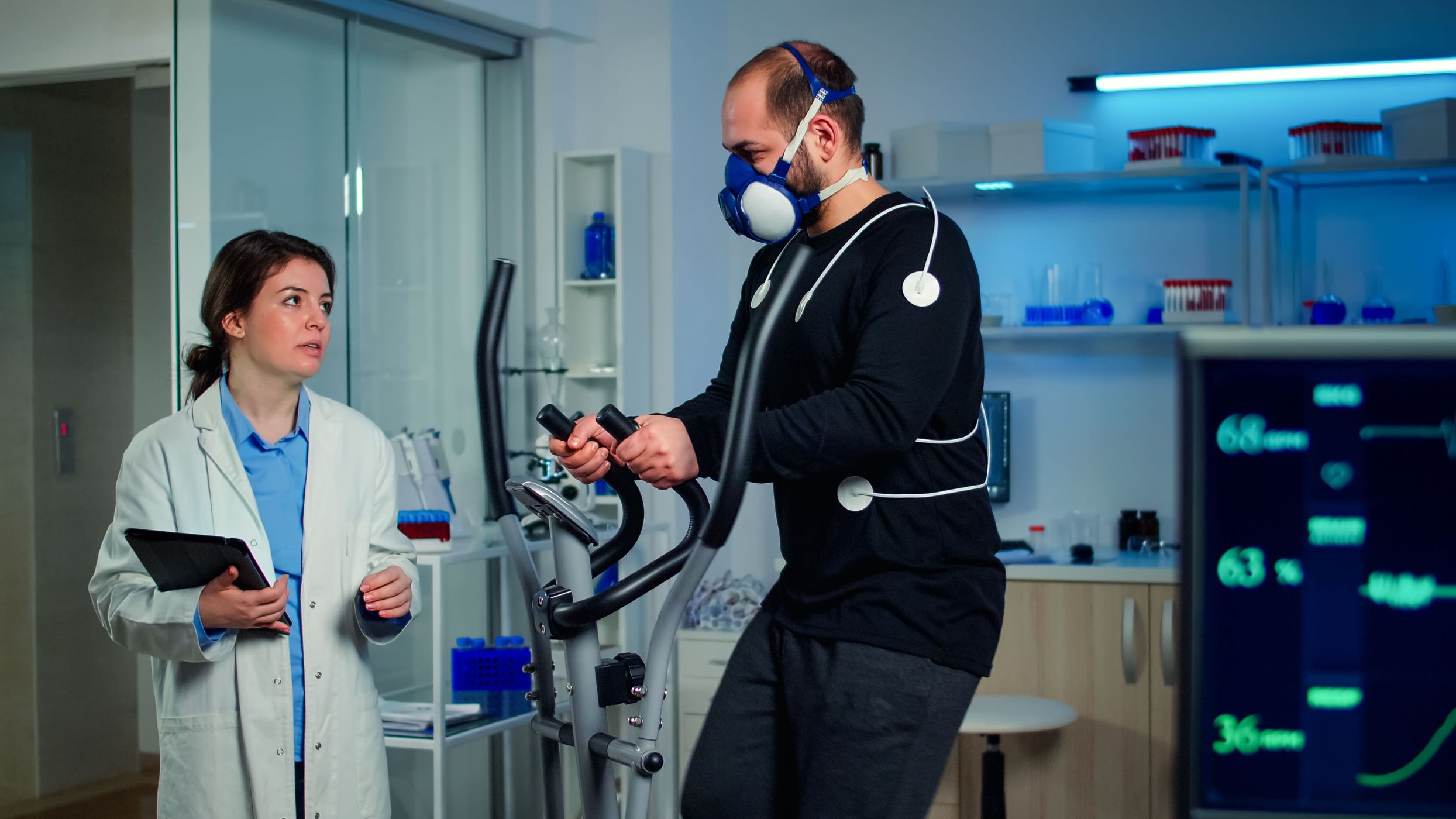Home>Misc>Featured>When Individuals Improve Their Aerobic Endurance Which Body Systems Are Affected?


Featured
When Individuals Improve Their Aerobic Endurance Which Body Systems Are Affected?
Modified: March 1, 2024
Improve your aerobic endurance and increase your physical performance with our featured workouts that target various body systems.
Introduction
Aerobic endurance, also known as cardiovascular endurance or cardiovascular fitness, refers to the ability of the body to sustain prolonged periods of exercise that utilize the aerobic energy system. When individuals work on improving their aerobic endurance, various body systems are affected in positive ways, leading to numerous health benefits.
Regular aerobic exercise has been shown to have a significant impact on overall health and well-being. It not only improves cardiovascular fitness but also strengthens the respiratory system, muscles, and bones. Additionally, it positively influences the endocrine, nervous, and immune systems. Understanding how these body systems are affected by improved aerobic endurance can provide valuable insights into the benefits of incorporating aerobic exercise into our daily routines.
In this article, we will explore how different body systems are influenced when individuals work on improving their aerobic endurance. By gaining a deeper understanding of these effects, we can appreciate the holistic impact of aerobic exercise on our overall health.
Let’s dive into each body system and examine the changes that occur as aerobic endurance improves.
The Cardiovascular System
The cardiovascular system, comprised of the heart, blood vessels, and blood, plays a central role in delivering oxygen and nutrients to the body’s tissues. When individuals improve their aerobic endurance, the cardiovascular system experiences several beneficial changes.
Firstly, the heart becomes stronger and more efficient. Regular aerobic exercise increases the heart’s ability to pump blood, resulting in a lower resting heart rate and a higher stroke volume. This means that with each beat, the heart pumps out a larger amount of blood, allowing for more effective circulation throughout the body.
Furthermore, aerobic exercise helps to dilate blood vessels and improve their elasticity. This leads to improved blood flow and reduced resistance, resulting in lower blood pressure. The increased circulation also allows for more efficient oxygen delivery to the muscles and organs, enhancing overall performance and reducing the risk of cardiovascular diseases.
Additionally, improving aerobic endurance leads to an increase in red blood cell production. Red blood cells contain hemoglobin, a molecule responsible for carrying oxygen from the lungs to the body’s tissues. With more red blood cells, the body can transport oxygen more effectively, enhancing stamina and reducing fatigue during exercise.
Overall, by improving aerobic endurance, individuals can enhance the efficiency of their cardiovascular system. This results in a stronger heart, improved blood flow, lower blood pressure, and enhanced oxygen transport, all of which contribute to better overall cardiovascular health.
The Respiratory System
The respiratory system, consisting of the lungs, airways, and respiratory muscles, is vital for the exchange of oxygen and carbon dioxide in the body. When individuals improve their aerobic endurance, the respiratory system undergoes several positive changes.
Aerobic exercise increases lung capacity and efficiency. As individuals engage in activities that require sustained aerobic effort, such as running or cycling, the demand for oxygen increases. This leads to the expansion of lung tissue and an increase in the volume of air that can be inhaled and exhaled with each breath. Consequently, individuals experience improved lung function and enhanced oxygen intake.
Moreover, aerobic exercise strengthens the respiratory muscles, including the diaphragm and intercostal muscles. These muscles play a crucial role in breathing, and by regularly challenging them through aerobic activities, they become stronger and more efficient in expanding and contracting the lungs. Enhanced respiratory muscle strength allows individuals to take deeper breaths and maintain steady respiration during exercise.
Additionally, aerobic exercise improves the efficiency of gas exchange in the lungs. As the demand for oxygen increases during exercise, the body adapts by improving the efficiency of oxygen transfer from the lungs to the bloodstream, and the removal of carbon dioxide from the bloodstream. This leads to better oxygen utilization by the body’s tissues and improved removal of waste products.
By improving aerobic endurance, individuals can experience significant enhancements in their respiratory system. These include increased lung capacity, strengthened respiratory muscles, and improved oxygen delivery and carbon dioxide removal. Ultimately, these improvements contribute to better overall respiratory health and increased stamina during aerobic activities.
The Muscular System
The muscular system plays a crucial role in physical movement and overall strength. When individuals work on improving their aerobic endurance, the muscular system experiences several positive adaptations.
Aerobic exercise stimulates the growth and development of muscles. As individuals engage in activities such as running, swimming, or cycling, the muscles are continually worked and challenged. This leads to an increase in muscle size, known as hypertrophy, as well as an improvement in muscle fiber composition. Aerobic exercise primarily targets slow-twitch muscle fibers, which are more resistant to fatigue and well-suited for endurance activities.
Furthermore, aerobic exercise improves muscular endurance. Regular participation in activities that require sustained aerobic effort increases the muscles’ ability to contract repeatedly over an extended period. This allows individuals to perform activities for a longer duration without experiencing muscle fatigue or soreness.
In addition to muscle growth and endurance, aerobic exercise also enhances muscular efficiency. It improves the delivery of oxygen and nutrients to the muscles, which are essential for energy production during exercise. As a result, individuals experience increased energy levels, improved muscle performance, and a reduced risk of muscle cramps or injuries.
Moreover, aerobic exercise contributes to overall body composition. It helps to decrease body fat and increase lean muscle mass. This not only improves physical appearance but also supports better metabolic health and boosts basal metabolic rate. Regular aerobic exercise, combined with appropriate nutrition, can lead to improved muscle tone and increased overall strength.
By consistently working on improving aerobic endurance, individuals can positively impact their muscular system. This includes increased muscle size, improved muscle fiber composition, enhanced muscular endurance and efficiency, and better body composition. These adaptations contribute to improved physical performance and overall muscular health.
The Skeletal System
The skeletal system, consisting of bones, joints, and connective tissues, provides support, protection, and structure for the body. When individuals focus on improving their aerobic endurance, the skeletal system experiences several positive effects.
Aerobic exercise is weight-bearing, meaning it places stress on the bones and stimulates bone mineral density. Regular participation in activities such as walking, jogging, or dancing helps to maintain and improve bone density, reducing the risk of osteoporosis and fractures later in life.
In addition to promoting bone health, aerobic exercise also strengthens the muscles around the bones. When individuals engage in activities that require sustained aerobic effort, the muscles pull on the bones, stimulating bone remodeling. This leads to increased bone strength and resilience, which is particularly beneficial for individuals at risk of age-related bone loss.
Aerobic exercise also improves joint health and flexibility. Engaging in activities like swimming or cycling promotes the movement of joints through their full range of motion, improving joint mobility and lubrication. This helps to reduce the risk of joint stiffness, pain, and age-related conditions such as osteoarthritis.
Furthermore, aerobic exercise supports the overall alignment and posture of the skeletal system. Regular participation in aerobic activities strengthens the muscles responsible for maintaining proper posture, thus reducing the risk of muscular imbalances and postural deviations.
By regularly engaging in aerobic exercise and improving aerobic endurance, individuals can experience positive adaptations in their skeletal system. These include improved bone mineral density, increased bone strength, enhanced joint health and flexibility, and better overall alignment and posture. These benefits contribute to maintaining a healthy skeletal system and reducing the risk of bone-related conditions.
The Endocrine System
The endocrine system, composed of glands that produce hormones, plays a critical role in regulating various bodily functions. When individuals work on improving their aerobic endurance, the endocrine system experiences several positive changes.
Aerobic exercise has a profound impact on hormone regulation. It stimulates the release of endorphins, often referred to as “feel-good” hormones. Endorphins act as natural painkillers and mood enhancers, promoting a sense of well-being and reducing stress and anxiety levels.
Furthermore, aerobic exercise helps to regulate insulin levels. Regular participation in aerobic activities improves insulin sensitivity, allowing the body to use glucose more effectively. This is particularly beneficial for individuals with insulin resistance or type 2 diabetes, as it can help in managing blood sugar levels and reducing the risk of developing chronic conditions.
In addition to insulin regulation, aerobic exercise also influences other hormones involved in metabolism and weight management. It can increase levels of growth hormone and catecholamines, which promote fat utilization and support lean muscle development. This can lead to improved body composition and a higher metabolic rate.
Aerobic exercise also positively affects hormone levels related to reproductive health. In women, regular aerobic exercise can help regulate the menstrual cycle and reduce symptoms of premenstrual syndrome (PMS). In men, it can improve testosterone levels, supporting better sexual health and vitality.
Moreover, aerobic exercise plays a role in reducing the risk of hormonal imbalances and related conditions such as polycystic ovary syndrome (PCOS) and metabolic syndrome. By improving overall hormone regulation, aerobic exercise contributes to better metabolic health and overall well-being.
By working on improving aerobic endurance, individuals can experience positive effects on the endocrine system. These include increased release of endorphins, improved insulin regulation, enhanced metabolism and weight management, and better reproductive hormone balance. These adaptations contribute to overall hormonal health and well-being.
The Nervous System
The nervous system, consisting of the brain, spinal cord, and peripheral nerves, is responsible for coordinating and controlling bodily functions. When individuals focus on improving their aerobic endurance, the nervous system experiences several positive changes.
Aerobic exercise has a direct impact on brain health and function. It stimulates the release of neurotransmitters such as serotonin, dopamine, and norepinephrine, which are involved in mood regulation and feelings of pleasure. Regular aerobic exercise has been found to help reduce the risk of mental health conditions, including depression and anxiety.
Furthermore, aerobic exercise enhances cognitive function and boosts brain power. It has been shown to improve memory, attention, and overall cognitive performance. Engaging in aerobic activities increases blood flow to the brain, promoting the delivery of oxygen and nutrients essential for optimal brain function.
Aerobic exercise also supports neuroplasticity, the brain’s ability to change and adapt. Regular participation in aerobic activities stimulates the growth of new neurons and the formation of connections between brain cells. This enhances learning and memory processes, while also contributing to the overall health and longevity of the nervous system.
In addition to brain health, aerobic exercise improves the function of the peripheral nervous system. It helps to strengthen and maintain the health of nerves, promoting efficient communication between the brain and the rest of the body. This can result in improved coordination, balance, and motor skills.
Moreover, aerobic exercise can help to reduce the risk of age-related cognitive decline and neurodegenerative diseases, such as Alzheimer’s and Parkinson’s. It promotes neuroprotective mechanisms, including the production of neurotrophic factors that support the growth and survival of neurons.
By consistently working on improving aerobic endurance, individuals can experience numerous benefits for their nervous system. These include improved brain health and cognitive function, enhanced neuroplasticity, better peripheral nerve function, and a reduced risk of age-related neurological conditions. These adaptations contribute to maintaining a healthy and vibrant nervous system.
The Immune System
The immune system acts as the body’s defense mechanism, protecting against harmful pathogens and foreign substances. When individuals work on improving their aerobic endurance, the immune system experiences several positive effects.
Aerobic exercise has been shown to enhance immune function. Regular participation in aerobic activities boosts the production of antibodies and immune cells, such as T-cells and natural killer cells. These cells are essential for recognizing and eliminating bacteria, viruses, and other pathogens, reducing the risk of infections and diseases.
Aerobic exercise also improves the circulation of immune cells. As individuals engage in aerobic activities, blood flow increases, allowing immune cells to move more freely throughout the body. This facilitates the detection and elimination of potential threats, as immune cells can reach various tissues and organs more efficiently.
In addition to enhancing immune responses, aerobic exercise helps to reduce inflammation. Chronic inflammation is associated with numerous health conditions, including heart disease, diabetes, and autoimmune disorders. Regular aerobic exercise has been found to decrease levels of inflammatory markers and promote a healthier inflammatory response, reducing the risk of chronic inflammation-related diseases.
Furthermore, aerobic exercise supports stress management, and chronic stress can have a negative impact on the immune system. Regular participation in aerobic activities helps to reduce stress levels and promotes a better balance of stress hormones, such as cortisol. This, in turn, supports a stronger immune system and overall well-being.
Moreover, aerobic exercise can contribute to the overall maintenance of a healthy microbiome. The microbiome, consisting of trillions of bacteria and other microbes in the body, plays a crucial role in immune function. Regular aerobic exercise has been associated with a more diverse and beneficial microbiome, which promotes a stronger immune response.
By consistently working on improving aerobic endurance, individuals can enhance their immune system’s functionality. These include a stronger immune response, improved circulation of immune cells, decreased inflammation, better stress management, and a healthier microbiome. These adaptations contribute to a more robust immune system and reduced susceptibility to infections and diseases.
Conclusion
Improving aerobic endurance has a profound impact on various body systems, leading to numerous health benefits. By engaging in regular aerobic exercise, individuals can experience positive changes in their cardiovascular system, respiratory system, muscular system, skeletal system, endocrine system, nervous system, and immune system.
The cardiovascular system becomes stronger and more efficient, leading to improved heart health and circulation. The respiratory system experiences increased lung capacity and efficiency, enhancing oxygen intake and delivery. The muscular system grows stronger, improves endurance, and supports better body composition.
The skeletal system benefits from increased bone mineral density and improved joint health and flexibility. The endocrine system regulates hormones more effectively, resulting in better mood, metabolism, and reproductive health. The nervous system experiences enhanced brain function, cognitive performance, and neuroplasticity.
Lastly, the immune system becomes stronger, with improved immune response, decreased inflammation, and better stress management. Overall, these adaptations contribute to better physical health, mental well-being, and reduced risk of various diseases and health conditions.
Incorporating aerobic exercise into our daily routines, such as running, cycling, swimming, or dancing, allows us to tap into these incredible benefits. Whether it’s hitting the gym, taking a brisk walk, or participating in group fitness classes, finding activities that raise our heart rate and challenge our endurance can lead to significant improvements in our overall health and quality of life.
So, lace up your sneakers, get moving, and witness the remarkable changes that occur within your body systems as you work on improving your aerobic endurance. Your heart, lungs, muscles, bones, hormones, brain, and immune system will thank you for it!









